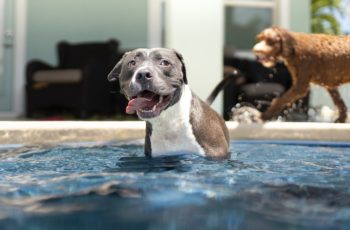Eye discharge in dogs isn’t its own disease, but rather a symptom of underlying issues. If your dog has eye discharge, the first thing you should do is determine the type of discharge and observe them for other symptoms.
In this article, we’ll discuss causes of eye discharge in dogs, five types of eye discharge, and when to call your veterinarian.
What Causes Eye Discharge in Dogs?
Eye discharge in dogs can be completely normal. Although dogs don’t cry like people, they do produce tears as a way to keep their eyes clean, and this can lead to some mucus, staining, or crustiness around the eyes. However, eye discharge can also be a symptom of serious eye problems, some of which can result in blindness if left untreated.
Later on, we’ll talk about the different types of eye discharge and how to tell which your dog has. For now, here are some causes of eye discharge in dogs:
- Sleep
- Watery eyes
- Allergies
- Inflammation
- Infections
- Eye injuries
- Debris in the eye
- Dry eye
- Eye ulcers
- Eyelid or eyelash abnormalities
- Blocked tear ducts
- Glaucoma
Your dog’s breed can also play a role in their eye discharge and how likely they are to have eye issues. For instance, brachycephalic (short-muzzled) breeds are much more likely to develop health problems related to their eyes.

Types of Eye Discharge in Dogs
Since eye discharge can present very differently in dogs, it’s important to know which type your dog has. Let’s break down the different kinds of eye discharge you may see in your pup.
Eye Boogers
If you’re new to dogs, you may not realize that they produce “eye boogers” like humans! This discharge might look dry and crusty or wet and goopy. You’ll notice it most in the morning or after your dog takes a long nap.
A vet visit isn’t warranted for this type of eye discharge unless it increases in volume, changes in color, or your dog presents with added symptoms like red eyes or itching.
Eye boogers can be wiped away with a damp cotton swab.
Tear Stains
Tear stains are usually a red-brown color and remain even when you wipe away a dog’s eye discharge. This is normal, especially for dogs with light-colored fur.
You can help prevent tear stains by wiping the area around your dog’s eyes regularly or trimming the fur short.
See a veterinarian if the staining becomes excessive or you notice other concerning symptoms.
Watery Eyes
Your dog’s eyes may water more if they get something in them, such as if they’re digging in the yard and dust and dirt flies into their face. It can also be a symptom of something more serious, such as glaucoma.
If your dog’s eyes seem abnormally watery, monitor them for other symptoms. If your dog appears to be in pain, the discharge becomes thick and mucusy, or they show other symptoms, see your veterinarian. If their eyes remain watery after a couple of days, you’ll also want to schedule an appointment.
Yellow/Green Discharge
Yellow or green discharge is often the result of an infection, either of the eye or another part of the body such as the respiratory system. It can also be a symptom of another underlying illness. These dogs should see the vet right away for treatment.
White/Gray Discharge
When a dog has a condition called dry eye, also known as keratoconjunctivitis sicca or KCS, their body will try to compensate by replacing normal tears with mucus. This results in a white or gray, mucusy discharge around the eyes.
You may also notice the following symptoms:
- Eye redness
- Pain
- Eye ulcers
- Abnormal corneal pigmentation
- Blindness
Other causes of white or gray mucus around the eyes include debris stuck under the eyelid and inflammation of the tear ducts.
See also

If your dog has this type of eye discharge, call your veterinarian right away. Dogs who don’t receive prompt treatment may go blind.

Other Symptoms to Watch For
It’s good to get into the habit of checking your dog’s eyes regularly, especially if you’re worried about their eye discharge. You’ll want to look for the following symptoms:
- Redness
- Itchiness or pain
- Dullness or cloudiness
- Squinting
- Third eyelid visible when the dog is awake
- Scratches or debris in the eyes
- Uneven pupils
If your dog’s eye discharge combined with these symptoms, please call your veterinarian and schedule an appointment. If their pupils are different sizes, call an emergency vet clinic immediately.
Home Treatments
Generally, you don’t want to attempt treatment at home if your dog is having eye issues. You can make the problem worse, cause pain or discomfort, and are unlikely to resolve the issue. This is especially true if your dog has yellow, green, white, or gray eye discharge, as we discussed above.
If your dog simply has a bit of crust under their eye or tear stains, these can usually be dealt with at home as they aren’t always a sign of illness. Use a damp cotton swab to gently wipe beneath the eyes a few times a day, or as needed to keep them clean.
If your dog has long hair, keep it trimmed short around the eyes so that it doesn’t become stained. However, staining is only an aesthetic problem. It looks bad, but doesn’t cause any health problems for your dog.
Final Thoughts
If your dog has eye discharge, don’t panic! It may be normal for them, or a symptom of a small problem such as debris in the eye or allergies. However, due to the risk of more serious ailments, always watch for further symptoms and see your veterinarian as needed.
This includes when the discharge is abnormal for your dog, lasts for more than a few days, changes in color or consistency, or presents with other symptoms like redness, itching, or pain.


